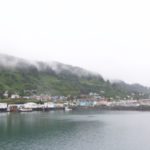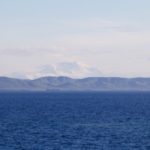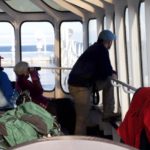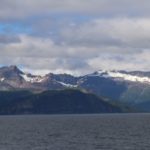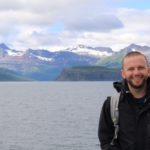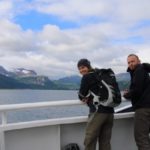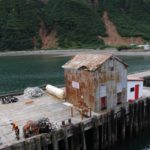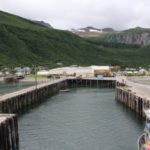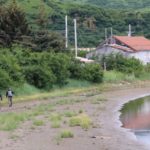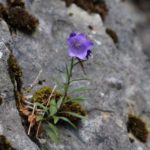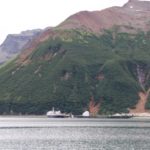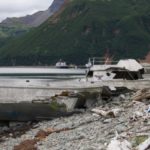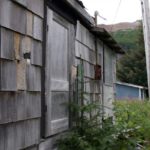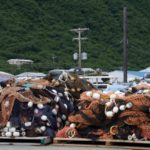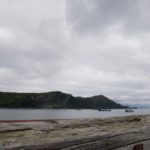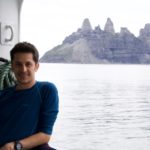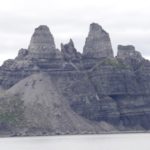27-28 July.
We left Kodiak in a rainy afternoon on 27th July. The fog covered the mountains, and in the horizon the lead-coloured sea merged with the grey clouds. In the shore, not far from port, about twenty sea lions laid on the sand. As we pulled out we also saw sea otters, bald eagles and, later, horned puffins, humpback whales, gulls, and (maybe) a white-winged scoter. The sailing was smooth, and we spent a long time in the solarium, looking out to the sea. I finally had an early night with no insomnia, and walked up this morning at 7:30am, fully recovered.
When we got to the deck, the ship was passing Mount Aniakchak, a massive volcanic caldera, covered with snow. On the south side we had the Semidi Islands, a group between the Alaska Peninsula and Chirikof Island. This is what I imagined the trip to look like. And it was only the start of our sailing to the Aleutians. A few hours later we approached the port of Chignik, the first stop in our sea trip.
Chignik is a small fishing town on the Alaska Peninsula. A few fishing boats moved around the bay. Around it, sea cliffs, and snow-capped mountains with waterfalls catching the snow melt. The mountains are covered in vegetation, except where the slopes are so steep that the erosion prevents the green crust to accumulate. The cliffs reveal a layered structure of gray and dark material, and in other parts the mountain breaks into red cliffs. The parallel lines of the mountain face are pushed up at places, broken along fracture lines. The land is made by volcanos and it is continually broken by tectonic plaques crashing into each other.
The small village of Chignik is mostly a canning factory and a group of wooden houses near the harbour. The houses are full with character and of an age impossible to determine. They could be eight years old or eighty. It is hard to decide if the shedding paint is caused by old age or by the merciless weather.
At port, we only had about an hour to search for monkey flowers before the boat left again. We were both excited and nervous to try finding them there. As soon as we disembarked, we headed west and searched along the river and on the beach. The beach was made of irregularly shaped pebbles, and only in patches you could see a dark grey sand. Drift wood and seaweed marked the line of high tide. We saw many flowers and bumblebees, but no monkeyflowers. In a rush we crossed a dilapidated bridge over the river along the coast, so we could examine the rock cliffs on the other side. The cliffs were a miniature botanic garden, with dwarf willow, yellow paintbrush, blue bells, Jacob’s ladder, and Sorbus. But no Mimulus here either. On the way back to the boat, we went along an old board walk that took us through the houses, some abandoned, others occupied, but in either case silent and ancient. The vegetation on the side of the path and road included yellow rattle, Solidago, fireweed, and others.
The doughnut shop had run out of doughnuts. Buying doughnuts in Chignik was what most people that came down the ferry did. The locals instead, rushed into the ferry to buy food at the restaurant.
When we boarded back, one of the crew said “Pretty nice, eh?” with a ring of sarcasm perhaps thinking that the small town of Chignik had disappointed us for being so bleak. We truly thought, “Yes, very nice indeed”. Even without finding monkeyflowers, Chignik had lived to our expectations of what a rough, hard-working town, at the edge of Alaska might look like.
—
It has been an hour since we left Chignik and two eventful things have happened. First, the general alarm sounded, with all crew reporting to their stations, and the intermittent call to abandon ship. It was a drill. The second is to be going around the geological cathedral of Castle Cape. Three jagged peaks of bare rock at the edge of the ocean, and multitoned layers of rock and ash at the edge of the Pacific Ocean.
—
The last stop of the day was Sand Point. At around 11pm we pulled into the harbour of the large city in the Alaskan Peninsula (952 people). A welcome committee was waiting for us at the docks. We were offered smoke salmon. The trucks in the dock were waiting for the passengers that have come in the ferry from Homer. There was a young couple that were attending a wedding, and their friends were happy and overwhelmed when they saw their old friends. There was a woman and her 12 day-old baby that were here to meet the baby’s father for the first time. And there were many more with unbelievable stories.
Jannice, Josh and I had a mission. With less than an hour on port, and the night closing in, we had limited time to find monkeyflowers. We split into two groups, and after a fruitless search to the left of the port I headed upwards, along a gravel road. Theys stayed searching among a scrapyard, and Josh spotted the first flowers. Hurriedly they stuffed plants in a bag and brought them to the ferry. The crew and passengers were so happy that we have finally found the plant we talked about for so long! “So, that’s the monkeyweed?” Asked an incredulous Australian pilot. We were tired, and satisfied to have found it. We processed the samples and I prepared two herbarium specimens. Sand Point had not disappointed us.

